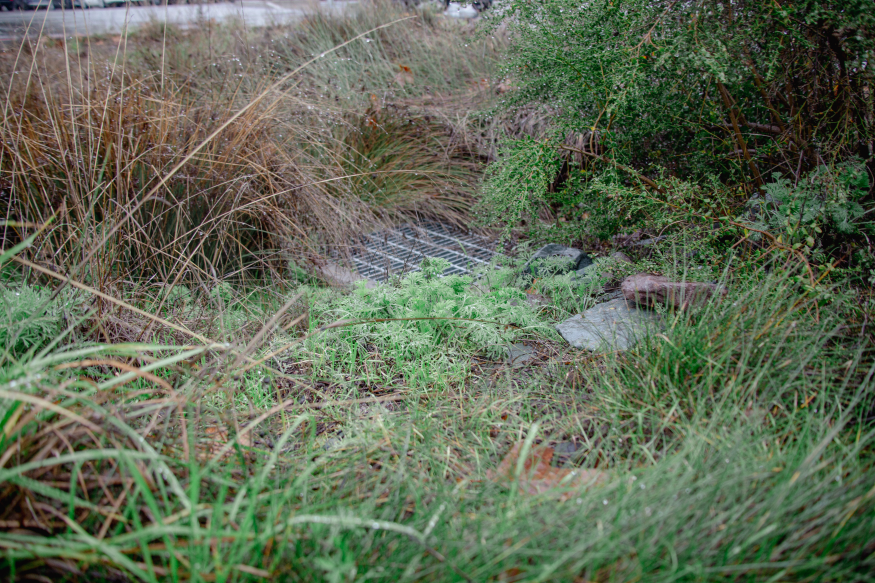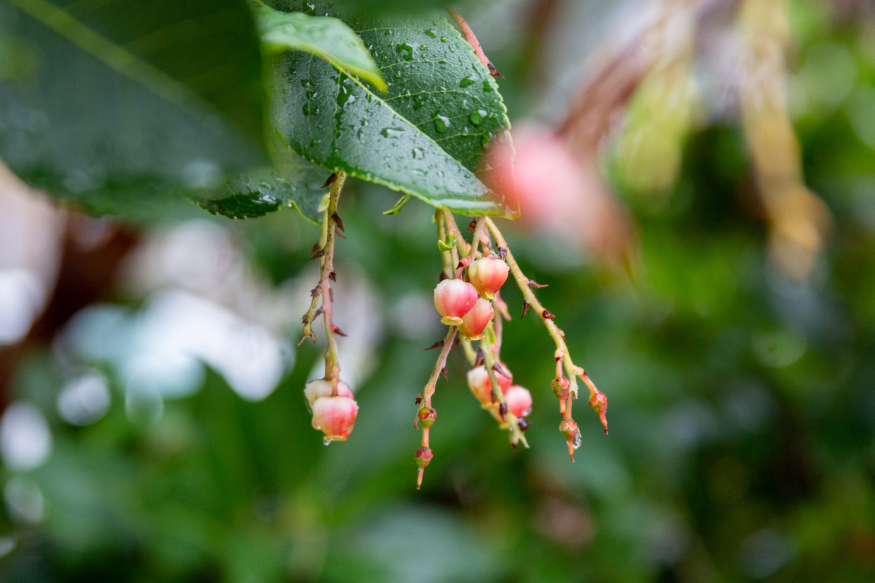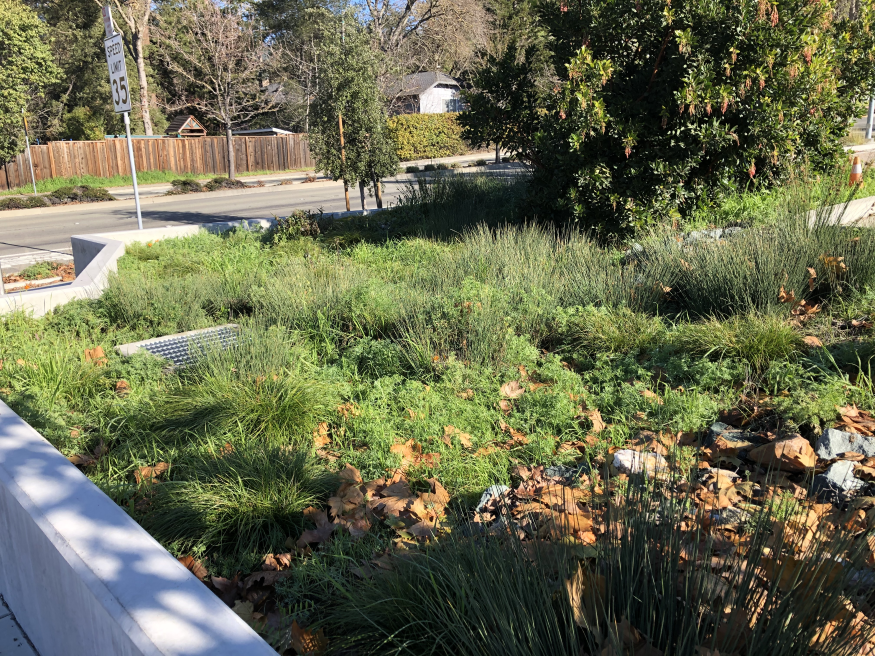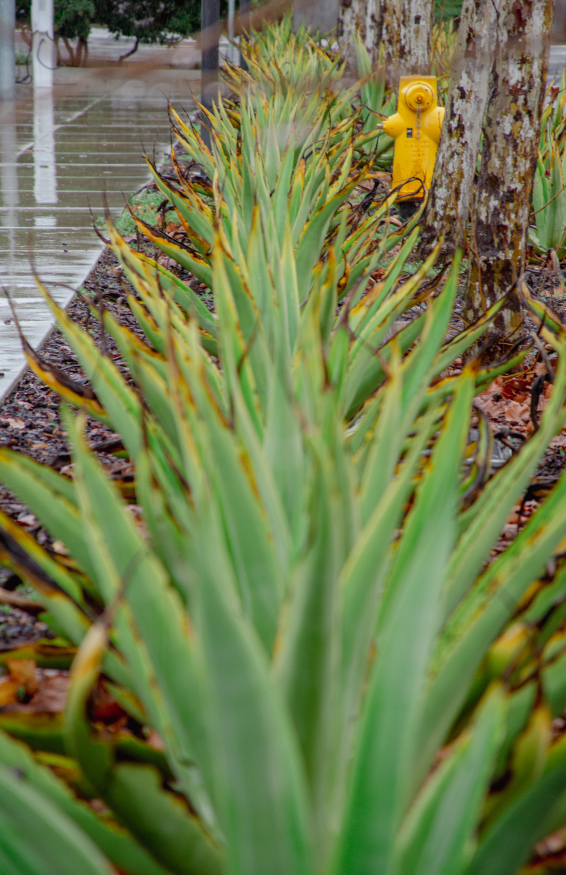With rainy season upon us, BART’s resplendent rain gardens are hard at work keeping local waterways clean

A rain garden at Lafayette Station during a storm.
The typically yellow hills surrounding Lafayette were green as emeralds on a recent rainy afternoon as yet another storm pummeled the already-inundated Bay Area region. While locals may be tired of all the rain, the region’s thirsty vegetation certainly is not.
At Lafayette Station, the northwest parking lot (next to Deer Hill and Happy Valley roads) houses multiple verdant rain gardens growing ferociously with predominantly native plants – strawberry trees with bright red fruit, dainty tomcat clovers, gloriously pink western redbuds, and golden California poppies that dance in the wind.
The plants have a job to do: filter out potential stormwater contaminants before the water flows onwards, into creeks and tributaries, rivers and bays.
But the flora also have a bonus gift for the creatures that encounter them: a feast for the eyes and the senses (and maybe a sheltered spot to alight for a few). On our recent visit, a tiny bird hid among the shiny leaves of the strawberry tree, a sweet chirp the only hint of its existence.
The planted areas are colloquially known as "rain gardens," but landscape architects now prefer the more specific term "bioretention areas," said BART Principal Landscape Architect Cynthia Greenberg.

Rain drips from a strawberry tree at Lafayette Station during a storm.
In recent years, BART has installed a series of bioretention areas at some stations as an environmentally friendly way to slow stormwater down and capture debris and pollutants from the runoff – before it enters our vital waterways. When stormwater flows over roads and rooftops, it picks up contaminants that can harm the region’s waterways and the flora and fauna that inhabit them. Possible contaminants include hydrocarbons, sediments, heavy metals, organics, trash, and oil or grease.
Currently, BART has bioretention areas at the Richmond Intermodal, Warm Springs Station, Berkeley Plaza, the Lafayette Intermodal, El Cerrito del Norte, and Antioch parking lot. On our visit to Lafayette Station, the bioretention areas were working exactly as expected. They looked especially gorgeous in the misty haze, with raindrops slowly drip, drip, dripping from the well-nourished leaves of the vegetation planted therein.
According to The Watershed Project, bioretention areas absorb “30% more stormwater into the ground than conventional lawns and reduce 70% of surface water pollution originating from stormwater runoff.” The plants, in addition to their aesthetic charms, also provide essential (albeit diminishing) habitats for fluttering butterflies and chittering birds. A 2019 report about the Lafayette Station bioretention areas found they were effectively filtering the stormwater as expected.
 The bioretention area at Lafayette Station on a sunny day.
The bioretention area at Lafayette Station on a sunny day.
At Lafayette Station, runoff from the parking lot is filtered by bioretention areas and directed to storm drains that release into Happy Valley Creek, a tributary of Lafayette Creek, which flows into Walnut and Pacheco creeks before emptying into the San Pablo Bay.
The bay is home to endangered species – including the California brown pelican, the California clapper rail, and the salt marsh harvest mouse – and a host of fish, such as striped bass, starry flounder, and leopard sharks. This is all to say, our waterways are highly connected; contaminated stormwater runoff can have ecological ripple effects across the region.
“This was an opportunity, from an environmental perspective, to help protect the region from stormwater pollution,” said Norman Wong, a Principal Engineer at BART who was the point of contact for the Lafayette stormwater improvement.

A line of agave plants at Lafayette Station during a storm.
Wong pointed to other green features at the station, including LED lights and solar panels in the parking lot. The piece de resistance for Wong, however, is the permeable pavement that covers some of the lot – a first for a BART property. Permeable pavement allows rainwater to infiltrate the ground and helps to reduce flooding. (Funding for the Lafayette stormwater project, including the bioretention areas, came from the State Water Resources Control Board via the Storm Water Grant Program.)
“If regionwide we do more of this,” Wong concluded, “we could have a huge improvement in stormwater flood protection – while helping the environment and its inhabitants.”
What Riders Can Do
- Put litter in its place: Dispose of trash into garbage and recycling receptacles provided by BART in our stations and parking lots.
- Use reusables: You can prevent litter by using reusable containers like travel mugs.
- Decline the printed receipt at BART ticket and parking machines if you can.
- Car maintenance: You may not be polluting but your car may be. If you drive to BART, please ensure your car isn’t leaking. Regular tune ups and leak inspections can prevent leaks or fix them if you have one.
- Car wash: The grime on your car that includes residue from gasoline, motor oil, and other chemicals can get washed off during a rainstorm if your car is parked in one of our outdoor lots. Help prevent this runoff by taking your car to a commercial or coin operated self-service car wash where all wash water is recycled and properly disposed of.
What BART is Doing
- BART has installed storm drain markers to inform the public that what goes down that drain flows to the bay.
- BART uses drought-resistant plants and efficient irrigation systems in our landscaping to preserve water and minimize run-off.
- BART cleans parking lots and plazas at least weekly to remove trash and pollutants.
- BART recycles the water used to wash train cars.
- BART has moved towards low-impact development (LID) as a standard practice, which is an approach to land development that works with nature to manage storm water as close to the source as possible.